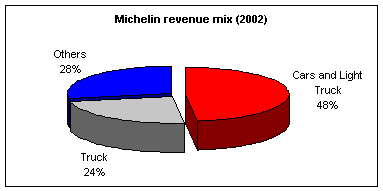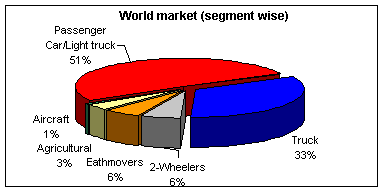- Home
- Outlook Arena
- Dec 1, 2003 - Apollo Tyres Vs Michelin
Apollo Tyres Vs Michelin
In a move that will have wide ranging implications on the Indian tyre industry, Apollo Tyres, India's largest manufacturer of bus and truck tyres, joined hands with Michelin, a transnational player, to manufacture tyres for the truck and the passenger car industry. Against this backdrop, let us compare the two companies across key financial parameters. Apollo Tyres: It is one of India's leading tyre brands and has a leadership in the truck tyre replacement market. Besides having a strong presence in the commercial vehicle OEM segment, the company also supplies to car and tractor OEM majors.
Michelin: Michelin, on the other hand, is a global behemoth and the world's largest tyre maker commanding a near 20% market share. It manufactures tyres for all the business segments viz cars, trucks and two-wheelers and even aircraft radial tyres. Besides tyres, the company is also into the manufacturing of suspension systems and has travel and tourism oriented publication services.

Since we are comparing two companies, which do not cater to the same market, it becomes imperative for us to have a look at the dynamics of the market that each of the two companies operate in.
Michelin is a market leader in a global tyre industry whose size is pegged at close to US$ 70 bn and where almost 85% of the demand comes from the car and truck segment. The world tyre industry is highly consolidated one and the top three players account for nearly 61% of the industry market share. Close to 87% of Michelin's revenue are generated from the mature markets of Europe and North America and therefore if the company has to grow at a faster rate in the future, it will have to concentrate on developing regions such as China and India.

Michelin's Indian counterpart, Apollo Tyres, operates in an industry whose size is estimated at US$ 2.7 bn (4% of world market share). The industry is expected to grow at a healthy rate of around 12% to 15% on account of availability of cheap financing for vehicles and ever improving road infrastructure. While the unorganized sector accounts for nearly 50% market share in low value add bicycle tyres, more than 70% of the market share in car, bus and truck tyres is constituted by top 5-6 players.
Let us have a look at how the two companies compare on various financial parameters:
| Parameter | Units | Apollo Tyres | Michelin** |
| Operating ratios | |||
| Net Sales | (Euro m) | 303 | 15,645 |
| CAGR-5 years | (%) | 14.8% | 5.8% |
| OPM | (%) | 10.3% | 14.9% |
| NPM | (%) | 5.9% | 3.7% |
| Sales/NFA | (x) | 2.0 | 2.7 |
| Working capital to sales | (%) | 13.1% | 39.9% |
| R&D as a % of sales | (%) | 0.3% | 4.5% |
| Return ratios | |||
| RONW | (%) | 29.0% | 12.9% |
| ROIC | (%) | 20.9% | 9.1% |
| ROA | (%) | 11.7% | 3.6% |
| Valuation ratios | |||
| Current price | (Rs)* | 242 | 33 |
| P/E | (x) | 7.3 | 8.1 |
| P/BV | (x) | 2.2 | 1.0 |
| Market Cap/Sales | (x) | 0.6 | 0.3 |
| EV/EBDITA | (x) | 7.9 | 6.5 |
Revenues of Apollo Tyres have grown at a faster clip than Michelin mainly on account of the fact that Apollo Tyres is present in a developing country, which has seen a surge in the sales of automobiles owing to introduction of newer models and relatively hassle free financing. Michelin, on the other hand, is present in mature and developed markets and as a result has experienced modest growth rates in the past 5 years. Moreover, increased use of technologically superior tyres and better quality roads, help in ensuring the longevity of tyres, thus resulting in lower off take in the replacement market as well.
On the operating front, Michelin has proved to be more cost effective than its Indian counterpart mainly on account of its diversification and huge size that helps it to leverage on the economies of scale and command bargaining power over its suppliers. Apollo Tyres, however, steals the thunder from its counterpart by clocking higher returns at the net profit levels and also various return ratios.
As far as the alliance between the two is concerned, we believe that it is a win-win situation for both the companies. The alliance gives Michelin, an opportunity to gain a foothold in the Indian tyre market which is showing a lot of potential and it also does away with the need to set up a marketing network of its own as Apollo Tyres has one of the best distribution network in the country (around 4,000 dealers). Apollo Tyres, on the other hand, will benefit from the technical expertise of Michelin and help it come out with better variants in bus and truck radial tyres and thus help it maintain its leadership in this segment. Not only this, it will also help Apollo Tyres, make inroads into the car tyre market.
On the valuations front, the high valuation given to Michelin despite its presence in mature markets underscores the company's market leadership and the growing presence in emerging markets. The valuation of Apollo Tyres on the other hand, is likely to see an increase once the alliance with Michelin manifests itself in the bottomline growth of the company. However, the increase in rubber prices (major raw material for the tyre industry) and competition from cheaper imports from China might prove to be a cog in the Apollo wheel.


Equitymaster requests your view! Post a comment on "Apollo Tyres Vs Michelin". Click here!
Comments are moderated by Equitymaster, in accordance with the Terms of Use, and may not appear
on this article until they have been reviewed and deemed appropriate for posting.
In the meantime, you may want to share this article with your friends!